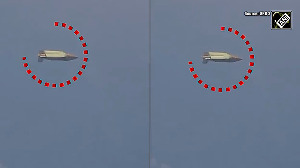Sushanta K Chatterjee is a young technocrat who works at the Central Electricity Regulatory Commission.
Having just released the thousand-page Commentary on the Electricity Laws of India, he knows well enough what is right, and not so right, with this sector. So I am pretty stunned when he categorically says that he would be more than willing to invest in power since the risk-reward equation is favourable.
Favourable? The Planning Commission data is telling me that the aggregate commercial losses of the states total over Rs 23,000 crore (Rs 230 billion) in 2004-05, and that these are projected to increase.
It also shows that the rate of return of the state electricity boards is a negative 32 per cent for that year. It is one sector where reforms seem to have been a non-starter as most of us are still suffering power cuts and paying for the inefficiencies of the power producers and distributors.
The apparent oxymoron can be resolved if we disaggregate data. There are state utilities today, which are cash positive. Yes, you read that correctly: c-a-s-h p-o-s-i-t-i-v-e. There are over 10 states that are earning a cash profit according to the latest data available (see table), though this figure includes the subsidy that has been being paid out by the respective state governments.| THERE IS CASH FLOWING IN | |
| State |
Cash profit 2004-05 Rs cr |
| Chattisgarh | 476 |
| Goa | 161 |
| Gujarat | 649 |
| Karnataka | 621 |
| Maharashtra | 2,209 |
| Orissa | 464 |
| Pondicherry (UT) | 79 |
| Sikkim | 56 |
| West Bengall | 713 |
| Andhra Pradesh | 1,231 |
| Punjab | 1,315 |
| Source: Power Finance Corporation | |
The very fact that subsidies are being released (in fact, subsidies are being deposited with the utilities upfront by state governments like Andhra, which dole out free power) is a good sign and we have to thank the discipline imposed by the electricity regulators for that.
There have been periods when committed subsidies have not been disbursed, causing a back hole in the entire chain of generation, transmission and distribution.
Though the data from the Power Finance Corporation (across 70 utilities) does not match that collated by the Planning Commission, which counts just a handful of states that are not incurring commercial losses, it does not refute the fact that some state utilities have seen a turnaround.
The most dramatic turnaround has been in Gujarat, which shows a cash profit of Rs 649 crore (Rs 6.49 billion) in 2004-05 against a cash loss of Rs 343 crore (Rs 3.43 billion) last year. But more on that later.
There are other positive signs too. The combined cash losses of all states have reduced sharply from Rs 18,918 crore (Rs 189.18 billion) in 2001-02 to Rs 3,438 crore (Rs 34.38 billion) last year (2004-05), after touching a low of Rs 2,268 crore (Rs 22.68 billion) in 2003-04.
There is an improvement in profit/reduction in losses across 36 utilities in 2004-05 (over the previous year) totalling Rs 2,718 crore (Rs 27.18 billion), though this stands dwarfed by the deterioration in profits/ increase in losses in 29 utilities amounting to Rs 4,536 crore (Rs 45.36 billion).
Here is something more to digest. Return on capital employed was "positive" for 53 utilities, but negative for 17. Excluding the states which have done badly - Uttar Pradesh, Punjab, Haryana, Jharkhand and Assam - the Rs 1,295 crore (Rs 12.95 billion) aggregate cash loss of performing states in 2003-04 (including subsidy released) was converted to a cash profit of Rs 1,730 crore (Rs 17.3 billion) in 2004-05.
The fruits of the labour put into the seminal Electricity Act of 2003 are finally coming to light. The law took five years and eight drafts to take shape and lays the framework for competition in all areas of the GTDC-chain or generation-to-transmission-to-distribution-to-consumer-chain.
Transmission lines have been thrown open (open access), allowing any power generator or trader a fixed-fee-based ride on the transmission lines. There are as many as 19 power traders who are wheeling power on these lines from one end of the country to another and pocketing obscene margins, which the regulator has recently stepped in to curb.
Large consumers (1 mw or above) are gradually being given the option to choose their source of power (open access at the consumer's end). Of course, there is a "surcharge" payable on each unit of power consumed to compensate the distribution licensee for the capital cost that such a move entails and also to cross-subsidise the not-so-large-users.
Industry officials say that the surcharge is so high - it ranges from 115 paisa per unit in Karnataka to 184 paisa per unit in Gujarat - as to make the option of switching the source of power prohibitive for the consumer.
Nevertheless, there are a few companies, which have made use of the open access provisions, mostly to switch to captive power (see table). This number is likely to go up as surcharge calculations are harmonised across states (substituting average cost of supply and embedded cost method to a mix of avoided cost and embedded cost, as per the tariff policy), and as more states finalise such regulations.
Carrot-and-no-stick policy
The power story is not all hunky-dory though. While the basic administrative, legal and regulatory framework is in place for an efficiently functioning sector, there are still large potholes on the road to serious efficiencies across the whole GTDC chain.
The biggest battle will, of course, continue to be with the albatross of transmission and distribution losses, which still drain away almost 37 per cent of the power generated on average, against an acceptable limit of 10-15 per cent.
The T&D losses are reducing by 1-2 per cent every year, more in some states than in others, but it is also true that they have gone up in some states.
This is despite thousands of crores {over Rs 7,500 crore (Rs 75 billion)} spent on programmes like APDRP (Accelerated power development and reform programme), which provide funding and incentives to states for distribution reform.
"APDRP in its current form has not sufficiently improved efficiencies. At the Planning Commission, we feel that there is a need to expand the scale of APDRP and improve incentivisation," says the deputy chairman of the planning commission, Montek Singh Ahluwalia.
So there is an APDRP II on the anvil which will focus on taking metering one more step closer to the consumer - and make it that much easier to track and eliminate leakages. The target is to bring down the AT&C losses to 15-20 per cent on a much sharper time curve.
The wise old men at the Planning Commission talk of technology-led initiatives like GIS (geographic information system) mapping of consumers, some of which have been successfully tried in turnaround states like Gujarat. Here is what the state is doing right. It has divided the state territory into smaller manageable circles and made each one a separate profit centre.
There is an intensive metering exercise and regular energy accounting and auditing for each centre and this has improved collections dramatically. Theft is down, thanks partly to police stations set up exclusively to check thieving. The optimists say that if one state can do it, so can others. There is of course a case for imposing penalties on states with increasing T&D numbers (see table) but I am told that pragmatism dictates a carrot-and-no-stick policy.| THE GOOD, BAD AND UGLY | ||
| Reduction in AT&C* losses in 2004-05 vs yr ago |
States | |
| 0-2% | 9 | Meghalaya, Tripura, J&K, Punjab, Karnataka, Kerala, Pondicherry, Tamil Nadu, Gujarat |
| 2-4% | 3 | Bihar, Sikkim, Chattisgarh |
| Above 4% | 9 | West Bengal, Assam, Mizoram, Nagaland, Delhi, Rajasthan, Uttar Pradesh, Goa, Maharshtra |
| Increase in AT&C* losses in 2004-05 vs yr ago |
States | |
| 0-2% | 1 | Haryana |
| 2-4% | 2 | Jharkhand, Uttaranchal |
| Above 4% | 6 | Orissa, Arunachal Pradesh, Manipur, Himachal Pradesh, Andhra Pradesh, Madhya Pradesh |
| *While T&D loss measures the gap between energy supplied and energy billed, AT&C (Aggregate Technical and Commercial loss) is seen as a superior measure as it gauges the gap between energy supplied and actual rupees recovered. | ||
| Source: Power Finance Corporation | ||








 © 2025
© 2025